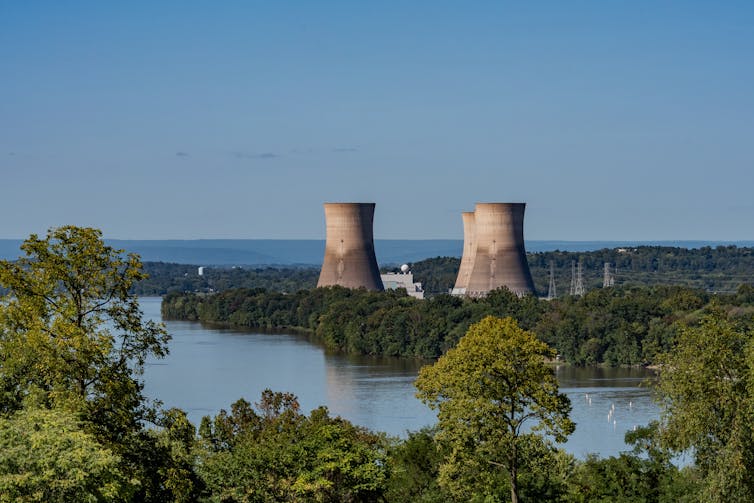After years of public discourse related to its safety, costs and waste, nuclear power is making a comeback as a core energy solution. Across North America, nuclear power facilities are being started, rebooted and extended.
In Saskatchewan, SaskPower — the province’s principal electric utility Crown corporation — has initiated its plans to add nuclear power into its energy portfolio. SaskPower’s strategy involves the addition of two small modular reactors over the next decade to reduce greenhouse gas emissions.
Support for nuclear power in Canada is mixed, as roughly 20 per cent support it, 20 per cent oppose it and 60 per cent are unsure or have mixed feelings about it.
In American states like California, nuclear power has had a tumultuous history that includes protests, legal challenges and public safety concerns.
A notable example is Diablo Canyon, the state’s last operational nuclear power plant. In 2016, Pacific Gas & Electric Company announced its closure. However, its operation was extended to 2030 after a 2021 report showed that its closure would result in nine per cent of the state’s power being lost and rolling blackouts.
Today, public sentiment related to nuclear power — and Diablo Canyon specifically — remains highly contentious. As nuclear energy regains momentum, its path forward will require rebuilding public trust.
Nuclear power in the U.S.
Recently, Microsoft and Constellation Energy announced plans to restart Unit 1 at Three Mile Island, a nuclear plant in Pennsylvania that is home of the worst nuclear disaster in United States history.
Unit 1 is a separate unit from the one that was shut down after a partial core meltdown released radioactive compounds into the environment in 1979. According to Microsoft, the revival is intended to support the immense power requirements of artificial intelligence.
However, public opposition in Pennsylvania has increased since the incident, with the Three Mile Island accident often being described as a setback that eroded nuclear energy support in the U.S. for an entire generation.

The Susquehanna River and Three Mile lsland in Pennsylvania. (Shutterstock)
While public sentiment varies by country, region and local history, support for nuclear power has largely been thought to depend strictly on the perceived benefits and risks.
My recent research with psychology professor Gordon Pennycook of Cornell University and marketing professor T.J. Weber of California Polytechnic State University confirms and extends our understanding of the types of nuclear power benefits that matter most.
Support for nuclear power
Over the last two years, we collected data from representative samples of Americans and Canadians using the international survey panel, Prolific. Our studies explored public sentiment, conspiracy beliefs, perceived benefits and risks, and willingness to support nuclear power.
According to our findings, the most important things to the public are economic spillovers or externalities, job creation in communities and clean energy. But we also found that support or opposition for nuclear power was much more complex, and was influenced by thinking styles, education levels and belief in conspiracies.
Previous research by Pennycook and his colleagues shows that support for nuclear power is highest among analytical thinkers. Irrespective of political affiliation, deliberate and analytical thinkers — as compared to intuitive and impulsive thinkers — are more likely to believe nuclear power is a safe and reliable source of energy.
Unlike other contentious topics, support for nuclear power is less about politics and more about critical thinking and knowledge.
Our research shows that people with high levels of scientific knowledge are more supportive of nuclear power. This finding aligns with another study we conducted on consumers and genetically modified food, which also demonstrated that education plays a crucial role in gaining public support.
Conspiracy beliefs and nuclear power opposition
Our research also found that scientific knowledge played an important role in reducing conspiracy beliefs. Our representative sample of Americans showed an above-average belief in nuclear power conspiracy theories.
We find that the most widely held beliefs included claims that the nuclear power industry illegally disposes of nuclear waste, that the industry and government deliberately covers up nuclear disasters, and that the scientific community downplays the risks of exposure to low levels of radiation from nuclear plants.
Unsurprisingly, we found that nuclear power support was highest among people with below-average beliefs in conspiracy theories. Put differently, those who believe in conspiracy theories are far less likely to support the industry.
Our research on both nuclear power and genetically modified foods indicates that scientific knowledge is positively correlated with support.
Education as the atomic solution
While governments and the nuclear industry have committed to advancing nuclear power, strategies to improve public sentiment have been nebulous until now.
As SaskPower embarks on its journey to introduce nuclear energy in Saskatchewan, the Pacific Gas and Electric Company extends the life of Diablo Canyon and Microsoft and Constellation Energy restart Three Mile Island, the industry faces serious public relations challenges.
Our research suggests that education and scientific knowledge are needed to improve the perception of the industry and obtain the social licences from communities. Public trust and acceptance are prerequisites for successfully advancing nuclear energy projects, particularly in light of historical controversies and persistent misinformation.
In addition to communicating the tangible benefits of nuclear power — such as job creation and economic development — scientific knowledge can also reduce the beliefs in conspiracy theories and improve the public’s perception of nuclear power.
Education campaigns should focus on dispelling myths and conspiracy theories while educating the public on the technological advancements of nuclear energy in the 21st century.
Public support and trust are difficult to gain, but easy to lose. Policymakers, regulators and industry must prioritize clear, effective messaging campaigns that emphasize operational safety, efficiency and energy sustainability
The first step is building public support. This hinges on communicating the salient benefits of nuclear power, building scientific knowledge and educating the public.



 Airline Loyalty Programs Face New Uncertainty as Visa–Mastercard Fee Settlement Evolves
Airline Loyalty Programs Face New Uncertainty as Visa–Mastercard Fee Settlement Evolves  Tesla Expands Affordable Model 3 Lineup in Europe to Boost EV Demand
Tesla Expands Affordable Model 3 Lineup in Europe to Boost EV Demand  Morgan Stanley Boosts Nvidia and Broadcom Targets as AI Demand Surges
Morgan Stanley Boosts Nvidia and Broadcom Targets as AI Demand Surges  Netflix’s Bid for Warner Bros Discovery Aims to Cut Streaming Costs and Reshape the Industry
Netflix’s Bid for Warner Bros Discovery Aims to Cut Streaming Costs and Reshape the Industry  EUR/USD Smashes 1.1660 as ADP Jobs Massacre Crushes the Dollar
EUR/USD Smashes 1.1660 as ADP Jobs Massacre Crushes the Dollar  Tesla Faces 19% Drop in UK Registrations as Competition Intensifies
Tesla Faces 19% Drop in UK Registrations as Competition Intensifies  Sam Altman Reportedly Explored Funding for Rocket Venture in Potential Challenge to SpaceX
Sam Altman Reportedly Explored Funding for Rocket Venture in Potential Challenge to SpaceX  Proxy Advisors Urge Vote Against ANZ’s Executive Pay Report Amid Scandal Fallout
Proxy Advisors Urge Vote Against ANZ’s Executive Pay Report Amid Scandal Fallout  Bitcoin Defies Gravity Above $93K Despite Missing Retail FOMO – ETF Inflows Return & Whales Accumulate: Buy the Dip to $100K
Bitcoin Defies Gravity Above $93K Despite Missing Retail FOMO – ETF Inflows Return & Whales Accumulate: Buy the Dip to $100K  Hikvision Challenges FCC Rule Tightening Restrictions on Chinese Telecom Equipment
Hikvision Challenges FCC Rule Tightening Restrictions on Chinese Telecom Equipment  Michael Dell Pledges $6.25 Billion to Boost Children’s Investment Accounts Under Trump Initiative
Michael Dell Pledges $6.25 Billion to Boost Children’s Investment Accounts Under Trump Initiative  GM Issues Recall for 2026 Chevrolet Silverado Trucks Over Missing Owner Manuals
GM Issues Recall for 2026 Chevrolet Silverado Trucks Over Missing Owner Manuals  Amazon Italy Pays €180M in Compensation as Delivery Staff Probe Ends
Amazon Italy Pays €180M in Compensation as Delivery Staff Probe Ends  Wikipedia Pushes for AI Licensing Deals as Jimmy Wales Calls for Fair Compensation
Wikipedia Pushes for AI Licensing Deals as Jimmy Wales Calls for Fair Compensation 



























